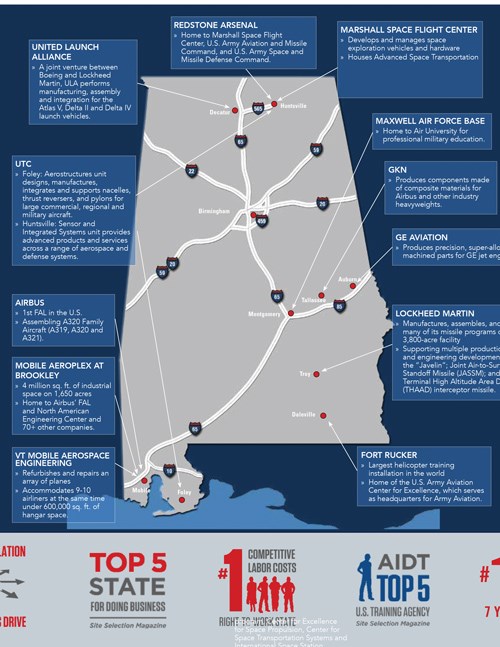Aerospace Finds a Home in Alabama
Alabama’s aerospace sector employs 83,000 people at more than 400 companies.
Alabama’s aerospace sector employs 83,000 people at more than 400 companies. With the Airbus A320 family assembly line under construction in Mobile, optimism is high that the sector is ripe for expansion.
“We are working hard to attract elements of the Airbus supply chain to Alabama while also increasing aerospace research and engineering activities that take place here,” Alabama Secretary of Commerce Greg Canfield says. “Our goal is to create more high-paying aerospace jobs and to spur more product development in the state.”
Airbus and Boeing are fierce competitors in the marketplace, but they have found common ground in Alabama, where both have substantial operations.
The Boeing Co. employs more than 2,600 people in Huntsville and is adding another 300-400 there to establish a technical research center. The company has been in Huntsville for more than 50 years, assisting NASA and playing a major role in the nation’s space program.
As for Airbus, before it began building its A320 family Final Assembly Line at Mobile Aeroplex in 2013, it already operated an engineering center there, with more than 220 employees performing work on A350 XWB and A380 aircraft. In addition, Airbus’ North American military aircraft unit has a maintenance, repair and overhaul (MRO) facility at Mobile Regional Airport.
But Airbus and Boeing aren’t the only big-name aerospace names operating in Alabama:
GE Aviation has a plant in Auburn that produces high-pressure turbine airfoils used in the company’s advanced jet engines.
Lockheed Martin is adding an annex to produce cruise missiles at its Pike County plant, where the Joint Air-to-Surface Standoff Missile is made. Lockheed Martin also makes unmanned aerial systems in Huntsville.
Raytheon is expanding a futuristic factory in Huntsville where SM-3 and SM-6 missiles are assembled.
Other major players with a presence in the state include Northrop Grumman, GKN Aerospace, UTC Aerospace Systems, ST Aerospace and Sikorsky.
Alabama also is a hotbed of helicopter-related activity.
“We have a robust rotorcraft presence in Alabama. Fort Rucker is the largest helicopter training center in the world, and there is obviously a large nucleus of maintenance techs to support the training craft fleet,” says Bob Smith, the Department of Commerce’s assistant director of business development and point man on aerospace.
Fort Rucker, near Ozark, has been the training center for U.S. Army helicopter pilots since 1955. In addition, the U.S. Army’s helicopter command is located at Redstone Arsenal in Huntsville. Bell Helicopter has worked with Northrop Grumman on an unmanned helicopter program at Bell’s facility in Ozark. (Bell also has a research center in Huntsville that focuses on unmanned aerial vehicles.)
Plus, Sikorsky has a manufacturing and assembly operation in Troy and a research and engineering center in Huntsville. Alabama Aircraft Support plans to open a MRO facility for helicopters in Enterprise, while Vector Aerospace last year announced plans to expand its helicopter overhaul facility in Andalusia. Source: Alabama Power and Alabama Department of Commerce
Related Content
-
Bryan Leiker, MFACA, Discusses CARB Public Hearing Over Calif. Hex Chrome Ban
Bryan Leiker, executive director, Metal Finishing Association of California, offers a recap of a January 27, 2023, public hearing conducted by the California Air Resources Board prior to an impending ruling on a proposed ban of hexavalent chromium use for finishing operations in the state.
-
Trivalent Chrome Overview
As the finishing industry begins to move away from the use of hexavalent chromium to trivalent chromium, what factors should finishers consider as they make new investments? Mark Schario, chief technology officer for Columbia Chemical offers a helpful overview of this complicated topic.
-
Finisher’s ‘Top Shop’ Status Attracts Business
This competitive California finisher made it a goal to become a PF Top Shop. After earning the recognition, the company experienced an immediate increase in business and a challenge to obtain certifications.
















.jpg;maxWidth=300;quality=90)
